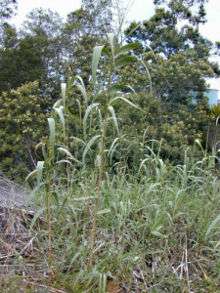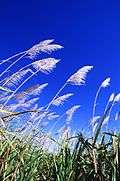Arundo
| Arundo | |
|---|---|
 | |
| Giant cane (Arundo donax) | |
| Scientific classification | |
| Kingdom: | Plantae |
| Clade: | Angiosperms |
| Clade: | Monocots |
| Clade: | Commelinids |
| Order: | Poales |
| Family: | Poaceae |
| Subfamily: | Arundinoideae |
| Tribe: | Arundineae |
| Genus: | Arundo Tourn. ex L. |
| Type species | |
| Arundo donax | |
| Synonyms[2] | |
| |
Arundo is a genus of stout, perennial plants in the grass family.
Arundo is native to southern Europe, North Africa, and much of temperate Asia as far east as Japan.[3] They grow to 3–6 m tall, occasionally to 10 m, with leaves 30–60 cm long and 3–6 cm broad.
- Arundo collina Ten.
- Arundo donax L. – Giant cane, Spanish cane (south and east Mediterranean, to India; naturalised in many additional areas and often invasive)
- Arundo formosana Hack. – Nansei-shoto, Taiwan, Philippines
- Arundo mediterranea Danin – Mediterranean
- Arundo micrantha Lam. – Mediterranean
- Arundo plinii Turra – Pliny's reed – Greece, Italy, Albania, Croatia
- formerly included[2]
over 200 species once considered part of Arundo but now regarded as better suited to other genera: Achnatherum, Agrostis, Ammophila, Ampelodesmos, Arthrostylidium, Arundinaria, Austroderia, Austrofestuca, Bambusa, Calamagrostis, Calammophila, Calamovilfa, Chionochloa, Chusquea, Cinna, Cortaderia, Dendrocalamus, Deschampsia, Dupontia, Gastridium, Gigantochloa, Graphephorum, Gynerium, Imperata, Indocalamus, Melica, Miscanthus, Molinia, Muhlenbergia, Neyraudia, Phalaris, Phragmites, Poa, Psammochloa, Rytidosperma, Saccharum, Schizostachyum, Scolochloa, Stipa, Thysanolaena, Trisetaria.
See also
References
- ↑ lectotype designated by Hitchcock, Prop. Brit. Bot. 121 (1929)
- 1 2 3 Kew World Checklist of Selected Plant Families
- ↑ Watson L, Dallwitz MJ. (2008). "The grass genera of the world: descriptions, illustrations, identification, and information retrieval; including synonyms, morphology, anatomy, physiology, phytochemistry, cytology, classification, pathogens, world and local distribution, and references". The Grass Genera of the World. Retrieved 2009-08-19.
- ↑ The Plant List search for Arundo
Further reading
- Douce, R. 1994. The biological pollution of Arundo donax in river estuaries and beaches. Pp. 11–13 In: Jackson, N.E. et al. Arundo donax workshop.
- Dudley, T. and B. Collins. 1995. Biological invasions in California wetlands: the impacts and control of non-indigenous species in natural areas. Pacific Institute for SIDES, Oakland, CA.
- Frandsen,. P. 1994. Team Arundo: a model for inter-agency cooperation. Pp. 35–40 In: Jackson, N. et al. Arundo donax workshop.
- Frandsen, P. and N. Jackson. 1994. The impact of Arundo donax on flood control and endangered species. Pp. 13–16 In: Jackson, N. et al. Arundo donax workshop.
- Hoshovsky, M. 1988. Element stewardship abstract: Arundo donax. The Nature Conservancy, San Francisco, CA.
- Iverson, M. Pp19–26 In: Jackson, N.E. et al. Arundo donax workshop.
- Scott, G.D. 1994. Fire threat from Arundo donax. Pp. 17–18 In: Jackson, N. et al. Arundo donax workshop.
External links
| Wikimedia Commons has media related to Arundo. |
| Wikispecies has information related to Arundo |
